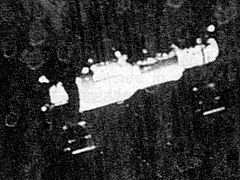Salyut 1

Salyut 1 as seen from the departing Soyuz 11.
|
|
 |
|
| Station statistics | |
|---|---|
| COSPAR ID | 1971-032A |
| Call sign | Salyut 1 |
| Crew | 3 |
| Launch | April 19, 1971 01:40:00 UTC |
| Launch pad | Site 81/24, Baikonur Cosmodrome, Soviet Union |
| Mass | 18,425 kg (40,620 lb) |
| Length | ~20 m |
| Width | ~4 m |
| Pressurised volume | 99 m³ (3,500 ft³) |
| Perigee | 200 km (108 nmi) |
| Apogee | 222 km (120 nmi) |
| Orbital inclination | 51.6 degrees |
| Orbital period | 88.5 minutes |
| Days in orbit | 175 days |
| Days occupied | 24 days |
| Number of orbits | 2,929 |
| Distance travelled | 118,602,524 km (73,696,192 mi) |
| Statistics as of de-orbit and re-entry | |
| Configuration | |

Soyuz docking with Salyut 1
|
|
Salyut 1 (DOS-1) (Russian: Салют-1; English translation: Salute 1) was the first space station of any kind, launched by the Soviet Union on April 19, 1971. More stations followed in the Salyut program, and heritage of that space station program is still in use on the ISS.
Salyut 1 originated as a modification of the military Almaz space station program then in development. After the landing of Apollo 11 on the Moon in July 1969, the Soviets began shifting the primary emphasis of their manned space program to orbiting space stations, with a possible lunar landing later in the 1970s if the N-1 booster became flight-worthy (which it didn't). One other motivation for the space station program was a desire to one-up the US Skylab program then in development. The basic structure of Salyut 1 was adapted from the Almaz with a few modifications and would form the basis of all Soviet space stations through Mir.
Civilian Soviet space stations were internally referred to as "DOS" stations, although publicly, the Salyut name was used for all Almaz and DOS stations. Several military experiments were nonetheless carried on Salyut 1, including the OD-4 optical visual ranger, the Orion ultraviolet instrument for characterizing rocket exhaust plumes, and the highly classified Svinets radiometer.
Construction of Salyut 1 began in early 1970 and after nearly a year, it was shipped to the Baikonur Cosmodrome. Some remaining assembly work had yet to be done and this was completed at the launch center.
Launch was planned for April 12, 1971 to coincide with the 10th anniversary of Yuri Gagarin's flight on Vostok 1, but technical problems delayed it until the 19th. The first crew launched later in the Soyuz 10 mission, but they ran into troubles while docking and were unable to enter the station; the Soyuz 10 mission was aborted and the crew returned safely to Earth. Its second crew launched in Soyuz 11 and remained on board for 23 days. This was the first time in the history of spaceflight that a space station had been manned, and a new record in time spent in space. This success was, however, overshadowed when the crew was killed during re-entry, as a pressure-equalization valve in the Soyuz 11 re-entry capsule had opened prematurely, causing the crew to asphyxiate. After this accident, missions were suspended while the Soyuz spacecraft was redesigned. The station was intentionally destroyed by de-orbiting it after six months in orbit, because it ran out of fuel before a redesigned Soyuz spacecraft could be launched to it.
...
Wikipedia
